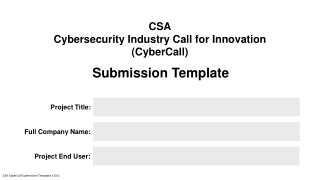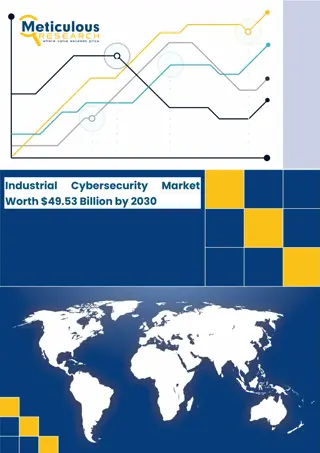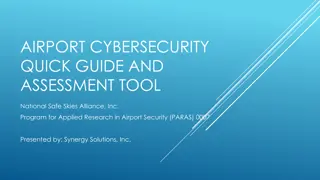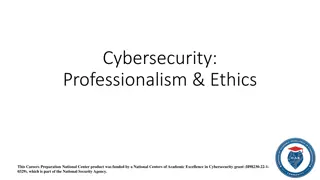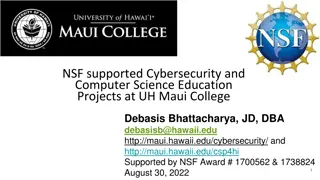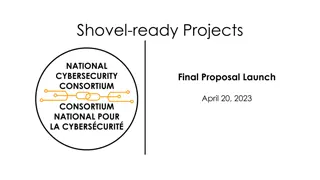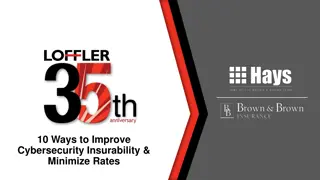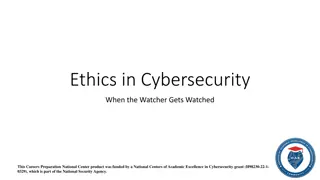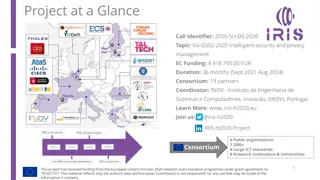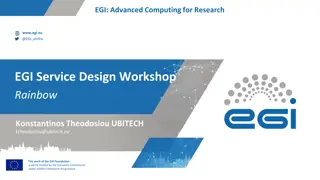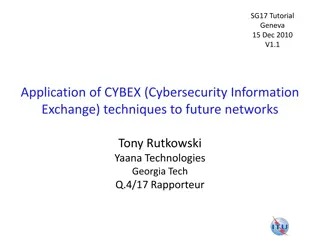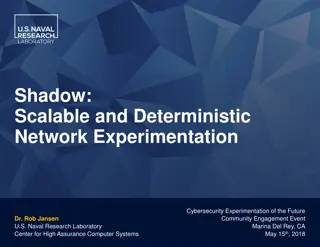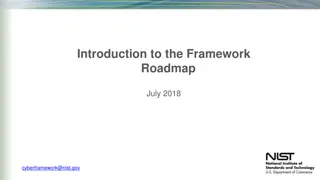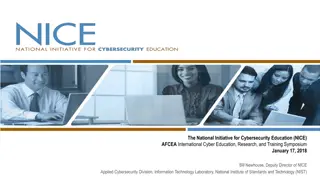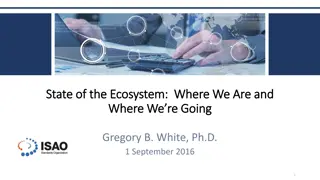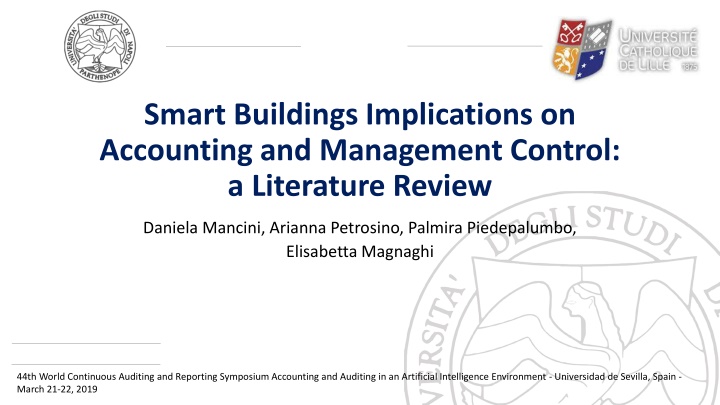
Opportunities in Horizon2020 Cybersecurity Call 2018 for Proposals
The evolving threat landscape in cybersecurity highlights challenges such as IoT device proliferation, blurring lines between state and non-state actors, hybrid attacks on democracies, and more. The Digital Security initiative in WP2018-2020 addresses critical cybersecurity issues in various sectors. Policy context emphasizes cybersecurity preparedness, NIS Directive, GDPR regulations, and more. Specific funding opportunities like SU-DS01-2018 focus on cybersecurity preparedness, cyber range, simulation, and economics.
Download Presentation

Please find below an Image/Link to download the presentation.
The content on the website is provided AS IS for your information and personal use only. It may not be sold, licensed, or shared on other websites without obtaining consent from the author. If you encounter any issues during the download, it is possible that the publisher has removed the file from their server.
You are allowed to download the files provided on this website for personal or commercial use, subject to the condition that they are used lawfully. All files are the property of their respective owners.
The content on the website is provided AS IS for your information and personal use only. It may not be sold, licensed, or shared on other websites without obtaining consent from the author.
E N D
Presentation Transcript
Smart Buildings Implications on Accounting and Management Control: a Literature Review Daniela Mancini, Arianna Petrosino, Palmira Piedepalumbo, Elisabetta Magnaghi 44th World Continuous Auditing and Reporting Symposium Accounting and Auditing in an Artificial Intelligence Environment - Universidad de Sevilla, Spain - March 21-22, 2019
Agenda Motivations Aims Methodology Literature analysis: sources and smart buildign concept Literature analysis: smart building models Literature analysis: topics and management issues Discussion Possible implications 44th World Continuous Auditing and Reporting Symposium Accounting and Auditing in an Artificial Intelligence Environment - Universidad de Sevilla, Spain - March 21-22, 2019 2
Motivations EU smart strategies Digitalization of organisational processes Advances in technological innovation EU 2020 policy Corporate Sustainability strategies Building consumed a great amount of energy Smart Technologies Sustainability Energy and Societal Transition Project Smart approach to sustainable development Smart building for energy transition Smart & Sustainability University Strategy Smart & Green Convergence 44th World Continuous Auditing and Reporting Symposium Accounting and Auditing in an Artificial Intelligence Environment - Universidad de Sevilla, Spain - March 21-22, 2019 3
Aims How could smart building impact Management Control Accounting 44th World Continuous Auditing and Reporting Symposium Accounting and Auditing in an Artificial Intelligence Environment - Universidad de Sevilla, Spain - March 21-22, 2019 4
Methodology I) Preliminary literature search II) Refining literature search III) Literature review WOS and Scopus database smart* building* keyword No restriction by subject smart* building* and intelligent building* Restriction to Business and Management subject Reading of the articles Classification by topics and other features Smart building concept Point of view IT focus Management concern Accounting and control issues Identification of keywords 8 scientific article in business and management Multi-disciplinary search 44th World Continuous Auditing and Reporting Symposium Accounting and Auditing in an Artificial Intelligence Environment - Universidad de Sevilla, Spain - March 21-22, 2019 5
Literature analysis: sources and smart building concept n. keyword definition author/s 1 intelligent building Intelligent buildings is those buildings that make extensive use of information technology for building applications, and business applications, and that are responsive to organisational and technological change. Oades, 1989 2 intelligent building It is a building which creates an environment that maximises the efficiency of the occupants of the building while at the same time allowing effective management of resources with minimum lifetime costs. [...] Robathan, 1991a 3 intelligent building The interconnection of devices, actuators, monitors and control units to form a unified system of control for a building or campus appears to be the perfect solution to achieving the intelligent building. Robathan 1991b 4 intelligent building Intelligent building have come into the spotlight recently and they will require an ever more specialised approach to building maintenance as a result of the complex integration of various systems including fire, security, access, air conditioning and communications. Sidney, 1992 5 intelligent building Thus, it is the performance of the intelligent building that is important and what intelligence does is manage the interfaces between the building, the organisation and the user, now and in the future. [...] As well as the integration of the building, organisation and the user, an intelligent building must work within the global and local environmental constraints. In this way the building can respond to future changes in legislation and social expectations and provide a healthy environment for its users. Boyd et al., 1993 6 smart building The addition of micro-electronic devices, such as sensor, can enable the setting up and operation of the so called smart buildings and smart ships. Fox et al., 2013 7 smart building Smarter building the use of sensor to collect data and develop analytics for identifying energy saving opportunities in building by modelling and analyzing how energy is consumed in buildings. Lee et al., 2014 8 smart building Iot-based application have opened up a growing market for smart building, intelligent building or smart-home projects and business models. [...] The mosaic of involved layers and components of the system, specifically: (1) the sensing, delivery and management layer [...]; (2) the data processing and modeling layer [...]; the smart building services buildings layer [...]. The entire building would be completely covered by the smart devices, which control all the intra- activities of resident and objects. This also facilitates the inter-system connection with other parties systems inserted such as a services providers, local authorities and other peripheral actors, which ultimately constitutes the larger ecosystem of smart-areas or even smart cities. Le et al., 2019 44th World Continuous Auditing and Reporting Symposium Accounting and Auditing in an Artificial Intelligence Environment - Universidad de Sevilla, Spain - March 21-22, 2019 6
Literature analisys: smart building models Boyde (1993) Le et al. (2019) Robatan (1991a) IB like the human body SB is made by three layers IB is an intelligent interface 44th World Continuous Auditing and Reporting Symposium Accounting and Auditing in an Artificial Intelligence Environment - Universidad de Sevilla, Spain - March 21-22, 2019 7
Literature analysis Point of view IT focus Management Concern Accounting and Management Control issues asset not a overhead, flexibility and obsolescence, different life span, life cycle approach, efficient, effective planning and management of the cable system Author/s Oades (1989) property professionals cabling infrastructure the introduction in the traditional building team of cabling specialists quality of control of services and facilities and systems, feedback provided by the infrastructure, control over cost/performance of building systems, planning and control of maintenance. occupants, managers of the building, owners, developers involved in creating the building telecommunications and networking internal, external, and integration with other services through a common cabling scheme and a unified cabling infrastructure open protocols for integrated communication between the individual components of a IB integrated management of building services and central control of building facilities to respond to environmental changes in an effective way Robathan, 1991a improve the communication between systems and devices at all level within an organization, cost of building control system clients of building control industry take under control the cost of integration of different devices and objects Robathan 1991b maintenance contractors/property managers resident organisation and users Computerised maintenance system planning preventive and reporting the costs and activities of maintenance planning and control of the cost of maintenance services and retention of building value over time Sidney, 1992 building performance measurement according different kind of needs, costs and value of refurbishment management intelligent building transition by refurbishment Boyd et al., 1993 costs of the implementation and management of technological systems, cost opportunities, predictive models for mantainace services, remote monitoring and reporting of the performance in use, supply chain relationships understand the patterns of energy usage, understand how occupants behaviours affect energy consumption, simulate the impact of possible changes, visualize building energy performance project businesses microelecronics devices use of BIG Data achieving informational and transformational effects Fox et al., 2013 building managers, operators and tenants facilities managers municipalities facilities management companies analitics and predictive model based on a matematic, statistic and fisic model use of analytics to identify energy savings opportunities in buildings Lee et al., 2014 smart platform for facilities services coordination the platform connect owners, tenants, and third parties (services companies) design of a business model collect insight on users behaviours for building services offers Le et al., 2019 44th World Continuous Auditing and Reporting Symposium Accounting and Auditing in an Artificial Intelligence Environment - Universidad de Sevilla, Spain - March 21-22, 2019 8
Discussion Lack of a general shared definition of smart buildings: equipment-centred; performance- centred; inteconnection-centred Literature on smart building is almost silent about its implications on accounting and management control The smart building issue is essentially analysed from the perspective of users, little attention is focus on firms that adopt a smart and sustainbility strategy Smartization of buildings implies the asset transformation from tangible to intangible/hybrid Complexity of the smart building: many different devices to collect varius data Necessity to manage in an effective way the cost of manteinance and costs of facilities 44th World Continuous Auditing and Reporting Symposium Accounting and Auditing in an Artificial Intelligence Environment - Universidad de Sevilla, Spain - March 21-22, 2019 9
Possible implications Accounting Completion Information ecosystem span Evaluation methods Management control New information sources New measures for behavioural control New opportunities for investment and operational cost budgets/cost accounting: results control Implication on environmental cultural control Smart Building as an Asset: from traditional tangible asset to an hybrid one 44th World Continuous Auditing and Reporting Symposium Accounting and Auditing in an Artificial Intelligence Environment - Universidad de Sevilla, Spain - March 21-22, 2019
Thank you for your attention ? Questions Daniela Mancini mancini@uniparthenope.it 44th World Continuous Auditing and Reporting Symposium Accounting and Auditing in an Artificial Intelligence Environment - Universidad de Sevilla, Spain - March 21-22, 2019

